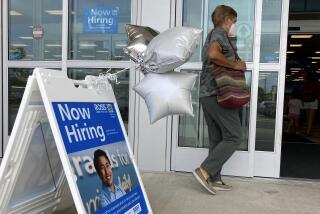Indicators Take Steepest Drop in Nine Months : Forecast: Analysts blame a record 25% drop in building permits. But results can be interpreted as indicative of a softer U.S. economy.
- Share via
WASHINGTON — The government’s main economic forecasting gauge plunged 1.0% in February, its steepest drop in nine months, the government said Tuesday. But analysts said the decrease was misleading.
The Commerce Department said Tuesday that its latest index of leading economic indicators--designed to forecast economic activity six to nine months in advance--wiped out three months of increases with the largest decline since a 1.1% fall last May.
But analysts said the report was an aberration caused by a record 25% drop in building permits in February from January’s 26.8% gain when builders took advantage of warm weather and tried to beat deadlines for new government rules requiring easier access for the handicapped to new buildings.
“It would have been down just 0.2% without the distorting effect of the building permits,” said David Jones, an economist with Aubrey G. Lanston & Co., a government securities dealer in New York.
Gilbert Benz, an economist with the Swiss Bank Corp. in New York, said the gauge would bounce back next month to its levels of late 1989 and early 1990. The index rose 0.1% in November, 0.4% in December and 0.2% in January.
Nevertheless, seven of the 11 statistics in the index were down, which analysts interpreted as meaning a soft economy, particularly in the manufacturing sector.
“February’s leading indicators show a substantial industrial rebound is unlikely to occur in the next six months,” said William K. MacReynolds, forecasting director for the U.S. Chamber of Commerce.
But Jones added, “Recent signals suggest that while the goods-producing sector is still flat, it’s not getting any worse and there’s no evidence that its weakness is spreading to other sectors.”
In addition to building permits, other statistics contributing to the index’s decline in February were faster business delivery times, lower stock prices, a decline in plant and equipment orders, a decrease in the price of raw materials, a decline in the backlog of manufacturers’ unfilled orders and a drop in an index measuring consumer confidence.
Three of the components were positive, including an increase in orders for consumer goods, a gain in the money supply and a drop in weekly unemployment claims.
One indicator, the length of the average workweek, was unchanged.
The various changes left the index at 144.0% of its 1982 base of 100. The index fell 0.6% from September through February after declining 0.5% the previous six months.
Meanwhile, the National Assn. of Manufacturers reported that the U.S. economy, increasingly subject to developments overseas, is likely to slow significantly later this year in response to higher interest rates in Germany and Japan.
But the industry group preducted a rapid rebound next year as the pending reunification of Germany and the transition by Warsaw Pact countries to market economies create a vast new market for U.S. exports to Europe.
NAM President Jerry J. Jasinowski said the economies of the world’s major nations have become so interconnected that major developments abroad often influence the U.S. economy more powerfully than domestic policies.
Jasinowski told a group of reporters that the key near-term economic event is likely to be next weekend’s scheduled meeting in Paris of the finance ministers and central bankers of the seven major industrialized countries.
Jasinowski said the United States should “assume a leadership role” in the so-called G-7 talks to stabilize exchange and interest rates and coordinate monetary policies. Besides the United States, the G-7 includes Britain, Canada, France, Italy, Japan and West Germany.
The Bush Administration, he said, should encourage a gradual rise in Japanese interest rates. That would bolster the faltering yen, he said, by attracting more foreign investment and would bring Japanese capital costs more in line with the rest of the world.
At the same time, Jasinowski said, U.S. officials should take steps to hold domestic interest rates steady or push them slightly lower to reduce the possibility of a recession during the second half of 1990.
INDEX OF LEADING INDICATORS: Feb.,’90: 144.0. Jan.,’90: 145.4. Feb.,’89: 145.6.
More to Read
Inside the business of entertainment
The Wide Shot brings you news, analysis and insights on everything from streaming wars to production — and what it all means for the future.
You may occasionally receive promotional content from the Los Angeles Times.










